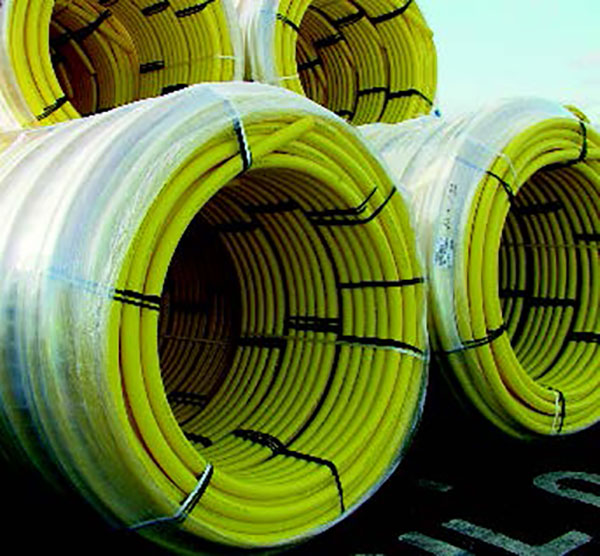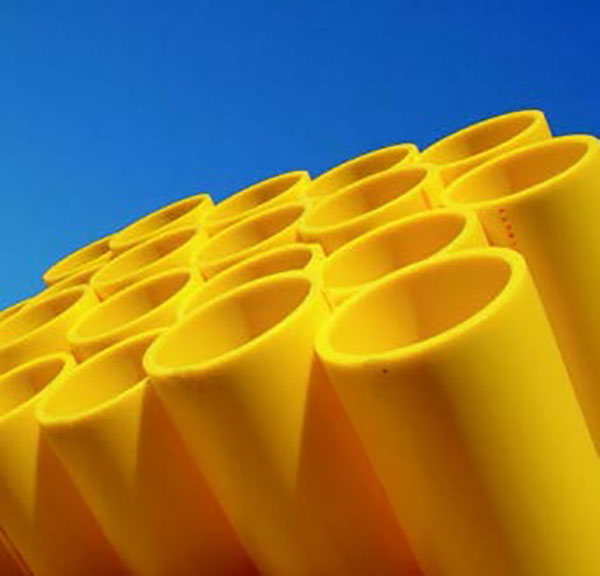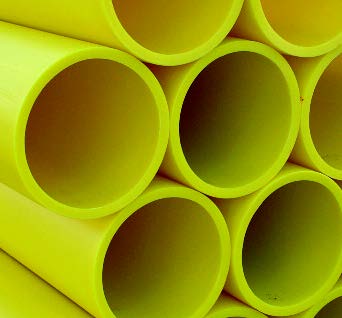JDP supplies PE80 pipes in yellow for gas distribution, in standard SDR11 & SDR17.6 ratings. PE100 pipes are also available for higher pressure applications.

SDR11 PE80 Polyethylene Coils
| Size (OD mm) | Wall Thickness (mm) | Nominal Bore (mm) | Approx Weight (kg/m) |
|---|---|---|---|
| 20 | 2.4 | 15.2 | 0.12 |
| 25 | 2.5 | 20.1 | 0.17 |
| 32 | 3.1 | 25.8 | 0.28 |
| 50 | 4.8 | 40.4 | 0.67 |
| 63 | 6.1 | 50.9 | 1.05 |
| Size (OD mm) | 6m | 50m | 100m | 150m |
|---|---|---|---|---|
| 20 | 090320G6 | 090320G50 | 090320G100 | 090320G150 |
| 25 | 090325G6 | 090325G50 | 090325G100 | 090325G150 |
| 32 | 090332G6 | 090332G50 | 090332G100 | 090332G150 |
| 50 | 090350G6 | 090350G50 | 090350G100 | 090350G150 |
| 63 | 090363G6 | 090363G50 | 090363G100 | 090363G150 |
SDR11 PE80 Polyethylene

| Size (OD mm) | Wall Thickness (mm) | Nominal Bore (mm) | Approx Weight (kg/m) |
|---|---|---|---|
| 90 | 8.6 | 72.9 | 2.10 |
| 125 | 11.9 | 101.2 | 4.04 |
| 160 | 15.2 | 129.8 | 6.61 |
| 180 | 17.0 | 146.0 | 8.36 |
| 250 | 23.6 | 202.8 | 16.10 |
| 315 | 29.7 | 255.6 | 25.54 |
| 355 | 33.5 | 288.1 | 32.43 |
| Size (OD, mm) | 6m | 12m | 50m | 100m |
|---|---|---|---|---|
| 90 | 1003090G6 | 1003090G12 | 1003090GC50 | 1003090GC100 |
| 110 | 1003110G6 | 1003110G12 | 1003110GC50 | 1003110GC100 |
| 125 | 1003125G6 | 1003125G12 | 1003125GC50 | 1003125GC100 |
| 160 | 1003160G6 | 1003160G12 | 1003160GC50 | 1003160GC100 |
| 180 | 1003180G6 | 1003180G12 | 1003180GC50 | 1003180GC100 |
| 200 | 1003200G6 | 1003200G12 | ||
| 225 | 1003225G6 | 1003225G12 | ||
| 250 | 1003250G6 | 1003250G12 | ||
| 280 | 1003280G6 | 1003280G12 | ||
| 315 | 1003315G6 | 1003315G12 | ||
| 355 | 1003355G6 | 1003355G12 |
SDR17.6 PE80 Polyethylene

| Size (OD mm) | Wall Thickness (mm) | Nominal Bore (mm) | Approx Weight (kg/m) |
|---|---|---|---|
| 90 | 5.4 | 79.3 | 1.38 |
| 125 | 7.4 | 110.3 | 2.64 |
| 180 | 10.6 | 158.9 | 5.45 |
| 250 | 14.7 | 220.7 | 10.49 |
| 315 | 18.4 | 278.2 | 16.63 |
| 355 | 20.8 | 313.5 | 21.11 |
| 400 | 23.4 | 353.3 | 26.78 |
| 450 | 26.3 | 397.5 | 33.88 |
| 500 | 29.2 | 441.6 | 41.81 |
| 560 | 32.6 | 494.8 | 52.53 |
| Size (OD, mm) | 6m | 12m | 50m | 100m |
|---|---|---|---|---|
| 90 | 1003090G76 | 1003090G712 | 1003090G7C50 | 1003090G7C100 |
| 110 | 1003110G76 | 1003110G712 | 1003110G7C50 | 1003110G7C100 |
| 125 | 1003125G76 | 1003125G712 | 1003125G7C50 | 1003125G7C100 |
| 160 | 1003160G76 | 1003160G712 | 1003160G7C50 | 1003160G7C100 |
| 180 | 1003180G76 | 1003180G712 | 1003180G7C50 | 1003180G7C100 |
| 200 | 1003200G76 | 1003200G712 | ||
| 225 | 1003225G76 | 1003225G712 | ||
| 250 | 1003250G76 | 1003250G712 | ||
| 280 | 1003280G76 | 1003280G712 | ||
| 315 | 1003315G76 | 1003315G712 | ||
| 355 | 1003355G76 | 1003355G712 | ||
| 400 | 1003400G76 | 1003400G712 | ||
| 450 | 1003450G76 | 1003450G712 | ||
| 500 | 1003500G76 | 1003500G712 | ||
| 560 | 1003560G76 | 1003560G712 |
Installation
EN13244:2003
Plastic piping systems for general purpose water, drainage and sewerage - polyethylene.
PE pipes can be jointed by Electrofusion or Butt-fusion. This method allows pipe to be fused outside of the trench, reducing the trench width required and minimising excavation.
For Electrofusion and Butt-fusion jointing see jointing guides at the end of the Fabricated Fittings section.
Laying of Pipes
The pipes should be installed in the trench with the pipe markings uppermost. Polyethylene may in some instances be laid directly onto the trimmed trench bottom where the soil is uniform, fine grained and free from large stones and flints.
In other cases the trench should be excavated to a depth to allow for a minimum 100mm bed of gravel, crushed stone or coarse sand. A sand/gravel mix is also acceptable, provided the gravel is less than 20mm in size.
Joint clearance holes should be dug into the trench to ensure pipe and sockets are laid level.
Pipes can be laid either in a conventional open cut trench and jointed in the trench, or a narrow trench where the pipes are jointed above ground and subsequently lowered into the trench.
The current practice in the UK is to lay service pipes at 750mm cover and mains pipes at 900mm cover, measured from the pipe crown.
The width of an open cut trench should be the minimum of pipe O.D. plus 250mm to allow for the correct compaction of sidefill and room to work in the trench.
The location of cables and pipes from other utilities should be identified prior to excavation and supported / protected throughout. Any damage should be reported.
Trench walls 1.2m and deeper must be supported – guidance on excavation techniques can be found in:
- BS 6031 Code of practice for Earthworks (general trenchworks)
- Report No. 97 Trenching practice (more specific advice)
- Report UM 1049 : 1990 (review of current practices)
Trench reinstatement in highways is covered in the NRASWA "Specification for the Reinstatement of Openings in Highways", 1992. This code was introduced with the aim that all highway reinstatement is completed as soon as possible to a consistent prescribed performance criteria.
Polyethylene is a flexible material and can deform under load without damage. It is however, important that any deformation is minimised and that the placement of the correct sidefill and initial backfill materials is carried out correctly with adequate compaction. Further details on bed and fill materials are given in WIS 4-08-01.
A minimum 100mm cover should be placed above the crown of the pipe, with heavy compaction equipment not being used with less than 300mm cover. Backfilling can then proceed in 300mm layers.
Trench backfilling should commence as soon as possible after pipe laying to give the pipe protection from damage from objects possibly falling into the trench. To protect the pipe from potential future interference damage it is good practice to install a marker tape 300mm above pipe crown.
Marker tapes can also include a tracer wire to allow future identification of the pipeline. See accessories section for marker tapes.
Handling and Storage
Take care when handling and storing pipes not to scrape and scuff the pipe. Scores and scrapes at less than 10% of the wall thickness will not affect the service performance.
Black, Black/Blue stripe and Black/Brown stripe polyethylene is UV stabilised providing it with excellent protection against UV radiation.
Blue and yellow polyethylene contains enough UV stabilisation to resist degradation in storage only. The maximum recommended storage outside, in the UK, is 12 months. Products stored for longer should be covered or stored inside.
Always
- Store pipes on level, firm ground
- Keep pipe away from sharp objects and stones
- Keep protective packaging intact until required for use
Never
- Drag or roll pipes
- Throw or drop pipe
- Use metal slings and hooks around the pipe
- Store pipes close to petrochemicals or other aggressive materials
